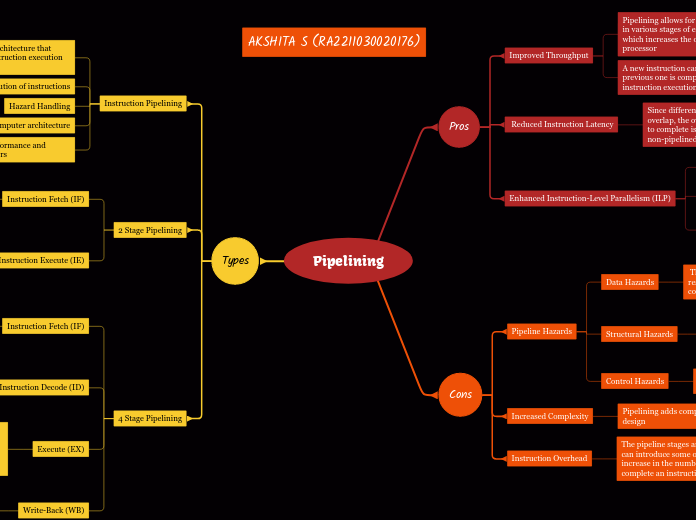Pipelining
Pros
Improved Throughput
Pipelining allows for multiple instructions to be in various stages of execution simultaneously, which increases the overall throughput of the processor
A new instruction can be started before the previous one is completed, leading to higher instruction execution rates.
Reduced Instruction Latency
Since different stages of instruction execution overlap, the overall time taken for an instruction to complete is significantly shorter compared to a non-pipelined processor.
Enhanced Instruction-Level Parallelism (ILP)
Pipelining is one of the techniques that enhances ILP
Allows a processor to execute multiple instructions simultaneously
This is particularly useful for executing different types of instructions (e.g., arithmetic, memory access) in parallel.
Cons
Pipeline Hazards
Data Hazards
These occur when an instruction depends on the result of a previous instruction that has not yet completed its execution
Structural Hazards
These result from resource conflicts when multiple instructions require the same hardware resource simultaneously. Structural hazards can lead to pipeline stalls or require additional hardware to alleviate the conflicts.
Control Hazards
These occur when there is a branch instruction that changes the order of instruction execution.
Increased Complexity
Pipelining adds complexity to the processor design
Instruction Overhead
The pipeline stages and associated control logic can introduce some overhead, leading to a slight increase in the number of clock cycles required to complete an instruction.
Types
Instruction Pipelining
Key technique in computer architecture that enhances the efficiency of instruction execution in a processor
Allows for overlapping execution of instructions
Hazard Handling
Fundamental concept in computer architecture
Plays a crucial role in the performance and efficiency of modern processors
2 Stage Pipelining
Instruction Fetch (IF)
In this stage, the processor fetches the next instruction from memory. It usually involves reading the instruction from memory or cache and updating the program counter to point to the next instruction.
Instruction Execute (IE)
In this stage, the processor executes the instruction fetched in the previous stage. Execution may involve operations like arithmetic computations, data manipulation, or control flow decisions.
4 Stage Pipelining
Instruction Fetch (IF)
this stage, the processor fetches the next instruction from memory or cache. It involves reading the instruction from memory, updating the program counter, and preparing the instruction for the subsequent stages.
Instruction Decode (ID)
In this stage, the processor decodes the fetched instruction to determine its type and the required operations. This stage also identifies any operands and registers needed for the instruction.
Execute (EX)
In this stage, the processor performs the actual execution of the instruction. This can involve arithmetic and logic operations, data manipulation, or control flow decisions, depending on the instruction
Write-Back (WB)
In this final stage, the processor writes the results of the executed instruction back to registers or memory. This stage ensures that the effects of the instruction are properly stored for subsequent instructions.
